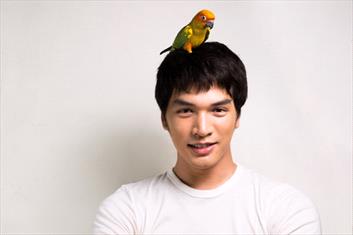bird on man's head

Photo courtesy of DepositPhotos
By now you've most likely heard that a pelleted (formulated) diet should make up the majority (70-80%) of your pet bird's diet. Saying this is all good and well for us bird veterinarians, but how can you achieve this at home? Well, like many things, there is more than one way to convert your bird to a healthy diet. You can use one approach, or combine them.
Gradual Introduction
With this technique you mix pellets in with your bird's regular food and slowly increase the percentage of pellets being offered.
- Typically I suggest that owners add 10% of the new food to the old food each day.
- For example you add 10% pellets to your bird's bowl on day one and 90% of the old (seed) mix. This way your bird will be exposed to the new food, but have plenty of opportunity to eat its regular food and not jeopardize its health by not eating at all.
- One day two you add 20% and so on. By the 10th day the bird is eating 100% of the new food. Birds should not eat 100% pellets, but you can offer the other foods separately, such as fruits, veggies and a small amount of seeds. Ideally you'd use the other foods, particularly the seeds, as a training tool.
No matter what approach you use, it is important to ensure your bird continues to eat. For some birds 10 days is too quick to allow for complete conversion. In these cases try changing the percentage every other day. This will mean a 20-day conversion period, rather than 10. Depending on your schedule you may or may not see your bird eating much. So how do you make sure your bird is getting adequate nutrition?
- Monitor your bird's droppings: you should get to know what your bird's normal droppings look like and the approximate amount of droppings produced on a daily basis. The color and consistency may change as your bird eats more pellets, but the total amount should not change significantly.
- Weigh your bird. This is an excellent practice to get into. I recommend people weigh their birds on a weekly or monthly basis if they are healthy, but if they are converting the bird's diet they should weigh them daily or every other day.
- Always weigh birds at the same time of day. Usually it's best to weigh them in the morning. If your bird's weight falls by 10% or more in any 1-week period, slow down on the diet conversion and contact your bird vet.
- Ideally, you should use a gram scale. These scales can be obtained in cooking and household stores, office supply stores, and at large online retail and auction sites.
Substitution
This approach is quite simple: Just offer the regular food in the morning and then remove that food at night and introduce the new pelleted diet.
- When you start doing this, remove the regular food just one hour before your bird's bedtime. This way he would have had plenty of time to eat during the day and will not starve himself by refusing the new food.
- By offering the food close to the end of the day you will take advantage of the bird's natural instinct to eat prior to nightfall.
- The trick is to gradually increase the amount of time your bird is exposed to the new food. Simply switch the food 10 to 15 minutes earlier each day until your bird is getting the new food for 3 to 4 hours prior to bedtime.
- If you notice your bird is not eating the new food, then move more slowly, perhaps increasing the time with the new food by just 5 minutes per day or 10 to 15 minutes every 2 to 3 days.
Flock Foraging
This technique works well for bird species that like to eat on the ground, such as cockatiels and budgies (parakeets). The approach is especially useful for tame birds.
- Ideally this should be performed first thing in the morning to take advantage of your bird's morning appetite.
- Put a mirror or white paper on the ground and scatter the pelleted food on it. This will make the food easier to see. The mirror may trick the bird into thinking her friend is eating pellets when it moves its head towards the food.
- With tame birds you can pretend to eat the pellets by forming a partial fist and plucking the pellets up with your thumb and index finger.
Ground-feeding birds will often take to pelleted food rapidly using this approach.
Good luck with this sometimes challenging, but always rewarding process. It can lead to life-long health benefits for your feathered friends.